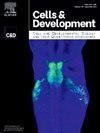fos genes in mainly invertebrate model systems: A review of commonalities and some diversities
IF 3.9
4区 生物学
Q4 Biochemistry, Genetics and Molecular Biology
引用次数: 0
Abstract
fos genes, transcription factors with a common basic region and leucine zipper domains binding to a consensus DNA sequence (TGA{}TCA), are evolutionarily conserved in eukaryotes. Homologs can be found in many different species from yeast to vertebrates. In yeast, the homologous GCN4 gene is required to mediate “emergency” situations like nutrient deprivation and the unfolded protein response. The C. elegans homolog fos-1 is required for reproduction and vulval development, as well as in adult homeostasis. In Drosophila melanogaster, there is also a sole fos homolog: the gene kayak, with five isoforms. The kayak locus has been studied in detail. It was originally described as embryonic lethal with a “dorsal open” phenotype. Since then, kayak has been shown to be required for oocyte maturation and as a source for piRNA; for early dorsoventral specification, macrophage function, dorsal closure, endoderm differentiation, and finally during metamorphosis in wing and eye-antennal development. In mammals there are multiple fos loci, each one with alternative splicing giving rise to multiple isoforms. Overall, mammalian fos genes are required for bone, cartilage and tooth formation, and in some instances for placental angiogenesis and retinal function. We review here mainly what is known about fos function in invertebrate model systems, especially during embryogenesis. We propose that fos genes, evolutionarily conserved transcription factors, evolved early during eukaryotic development, and from its inception as part of an environmental stress response machinery, were co-opted several times during development to regulate processes that may require similar cellular responses.

主要无脊椎动物模式系统中fos基因的共性与多样性综述
fos基因是具有共同碱基区和亮氨酸拉链结构域结合一致DNA序列(TGA{}TCA)的转录因子,在真核生物中是进化保守的。从酵母到脊椎动物,在许多不同的物种中都可以找到同源物。在酵母中,同源的GCN4基因需要介导“紧急”情况,如营养剥夺和未折叠的蛋白质反应。秀丽隐杆线虫的同源物-1是生殖和外阴发育以及成虫体内平衡所必需的。在黑腹果蝇中,也有一个唯一的同源基因:皮艇基因,有五个同工型。对皮艇轨迹进行了详细的研究。它最初被描述为具有“背开”表型的胚胎致死型。从那以后,皮艇被证明是卵母细胞成熟所必需的,也是piRNA的来源;对于早期的背腹侧发育、巨噬细胞功能、背侧闭合、内胚层分化,以及最后在翅膀和眼-触角发育的变态过程中。在哺乳动物中有多个fos位点,每一个都有不同的剪接产生多个同工异构体。总的来说,哺乳动物的骨骼、软骨和牙齿的形成需要fos基因,在某些情况下,胎盘血管生成和视网膜功能也需要fos基因。我们在这里主要回顾了已知的fos在无脊椎动物模型系统中的功能,特别是在胚胎发生过程中。我们认为,作为进化上保守的转录因子,fos基因在真核生物发育早期就进化了,并且从一开始就作为环境应激反应机制的一部分,在发育过程中被多次选择来调节可能需要类似细胞反应的过程。
本文章由计算机程序翻译,如有差异,请以英文原文为准。
求助全文
约1分钟内获得全文
求助全文
来源期刊

Cells and Development
Biochemistry, Genetics and Molecular Biology-Developmental Biology
CiteScore
2.90
自引率
0.00%
发文量
33
审稿时长
41 days
 求助内容:
求助内容: 应助结果提醒方式:
应助结果提醒方式:


